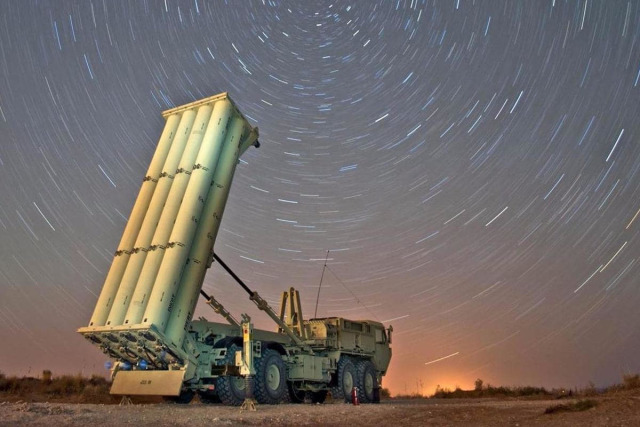According to the definition of the Missile Defense Agency of the US Department of Defense (Missile Defense Agency, MDA), the Terminal High Altitude Area Defense (THAAD) complex provides the missile defense system of the US Armed Forces with a "global mobile rapid deployment capability to intercept and destroy ballistic missiles inside or [only] outside atmosphere during their final (terminal) phase of flight". It is designed to protect the forces and facilities of the United States and its allies/partners, as well as the civilian population and infrastructure over a large area.
THAAD is configured to combat short-range and medium-range ballistic missiles (BRDD) and retains limited capabilities against long-range ballistic missiles (BRDD). The interceptor missile does not use a detonating warhead, but destroys the target due to the kinetic energy of a direct strike (the "hit-to-kill" method).
As with the upper-level missile defense system, THAAD interceptions are conducted at high altitudes. The exact performance parameters are classified. The maximum range of damage is usually estimated at about 200 km. The maximum intercept altitude is 150 km, the minimum is believed to be about 40-50 km.
It is believed that high-altitude interception has two main advantages: any nuclear, biological or chemical payload on board a flying warhead will be dispersed. This will reduce its lethality when the load reaches the ground. In addition, if the first high-altitude interception fails, there is time for a second attempt to intercept by means of THAAD or another missile defense system.
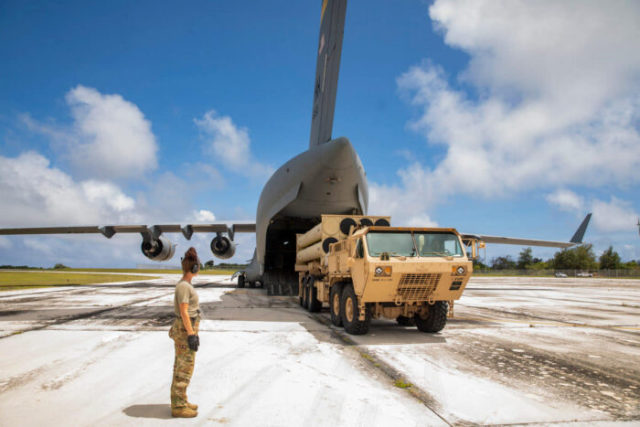
Unloading of THAAD PU from the C-17 Globemaster III military transport aircraft. Guam, March 2022.
While planning and procurement are carried out under the auspices of the MDA, THAAD batteries are operated and maintained by the US Army Air Defense Forces. THAAD batteries are integrated into a more advanced missile defense architecture through the control element. To form multi-level interception capabilities, they exchange tracking and targeting data with the Navy's Aegis missile defense system (which, like THAAD, is an upper-level interception system) and the lower-level Patriot army system. Interaction is carried out through the central command, control, combat control and communications system of the US Armed Forces (Command and Control, Battle Management, and Communications, C2BMC).
C2BMC is responsible for the continuous detection of targets, their tracking and targeting, as well as for the distribution of high-quality fire control data across all elements of the missile defense system. Sensor data from all parts of missile defense and aerospace surveillance are sent to C2BMC, where they are combined into a comprehensive threat picture and used to calculate the optimal response of various elements of the missile defense system. As the sources describe, each subsystem is aimed at different sections of the trajectory of an enemy missile or even at different threats, and the combined intelligence and communications system ensures that, if necessary, one or more interception subsystems will be involved.
THAAD Components
The Lockheed Martin Missiles and Fire Control division is the main contractor of the THAAD program, as well as a supplier of anti-missiles. The main components of THAAD include a launcher (PU), an interceptor missile (anti-missile), a radar, as well as a fire control and communications element. The standard configuration of the battery consists of six PU with a total of 48 ready-to-launch missiles, one control and communication element and one radar. However, the battery, at the same time, can control nine PU.
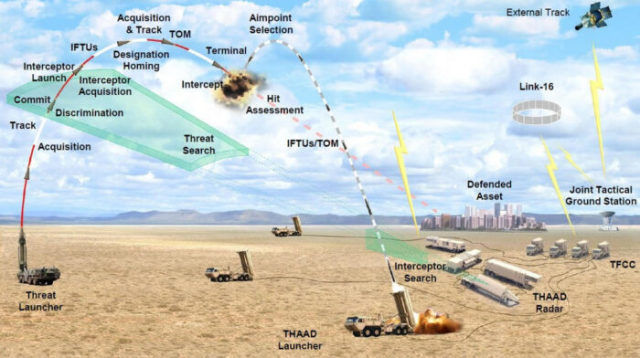
A scheme for combining THAAD elements to detect, identify and defeat an approaching missile
The launchers are mounted on heavy tactical cross-country trucks (Heavy Expanded Mobility Tactical Truck, HEMTT) A2 manufactured by Oshkosh Defense. The PU installed on the truck can be transferred to the theater of military operations (Theater of operations) by transport aircraft or ship. Inside the theater, it is transported using a C-130 aircraft, by rail or on its own over rough terrain. HEMTT capabilities allow you to overcome a slope of 60% and a ford with a depth of up to 1.2 m. Each PU carries eight anti-missiles. After firing its missiles, the PU is suitable for quick reloading in the field.
Lockheed Martin in October 2022 announced the delivery of the 700 THAAD missile defense system to the American missile defense system. The previous milestone of 600 delivered missiles was set in August 2021. The missile has a length of 6.2 m and a launch weight of 662 kg. It consists of one solid-fuel booster stage, a kinetic warhead filled with liquid fuel. It is claimed that the missile develops a speed of Mach 8. At this speed, it will reach the maximum interception range in less than 90 seconds, leaving the maneuvering target little time to evade.
To aim the anti-missile at the target, the THAAD complex uses the AN/TPY-2 radar produced by Raytheon Integrated Defense Systems, which provides updated tracking data up to the moment of collision. A radar with a high-resolution X-band phased array antenna can distinguish between the payload of missiles and other objects, for example, rocket debris. When deployed in terminal mode, the AN/TPY-2 is capable of interacting with all classes of BR-related threats and has a detection and guidance range of 1000 km. The radar antenna unit is 12.8 m long and weighs 34 tons and has two rear axles. They are used for towing during transportation and are disconnected for operation.
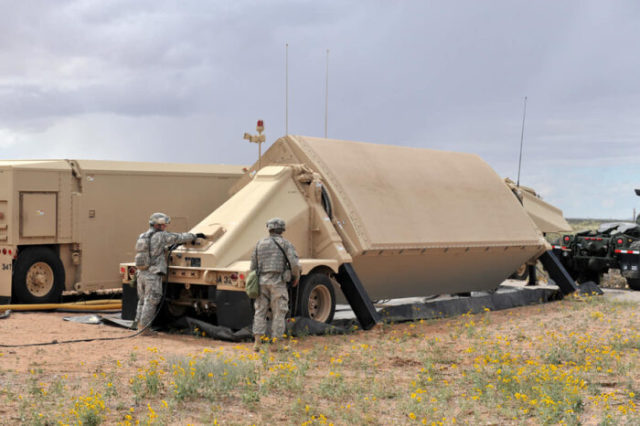
Raytheon AN/TPY-2 radar
The various subsystems of the THAAD battery are integrated into a single complex by the fire control and communications platoon. The unit plans and executes interception solutions, as well as provides an interface for the integration of the THAAD battery with C2BMC and interaction with external echelons of combat control.
Additional necessary battery elements include Humvee auxiliary trucks, a car with a main power unit producing 4160 volts, electronic equipment and a data processing unit, as well as a cooling device to maintain the operating temperature of the radar. To ensure operation, the various components of the battery are connected to each other using a fiber-optic cable. According to the US Army servicemen directly involved in the operation of THAAD complexes, the formation or relocation of a unit is a matter of hours or even days.
THAAD for today
The concept of THAAD originated in 1987, and the first test firing took place in April 1995. Initially, the program worked poorly. The first two shootings, none of which included interception attempts, were successful. However, the next six launches – all of which included interception attempts– ended in failure.
The program was restructured, and test firing resumed in August 1999 with the successful destruction of a warhead separated from a launch vehicle outside the atmosphere. The interception occurred at an altitude of 147 km . Since then, THAAD has allegedly demonstrated a high degree of efficiency and reliability. All 16 test intercepts conducted between 1999 and 2019 were successful, as were numerous experiments on non-interception and interaction. According to an assessment by the Congressional Research Service published in November 2022, many experts now "consider THAAD to be the most advanced missile defense system in the world."
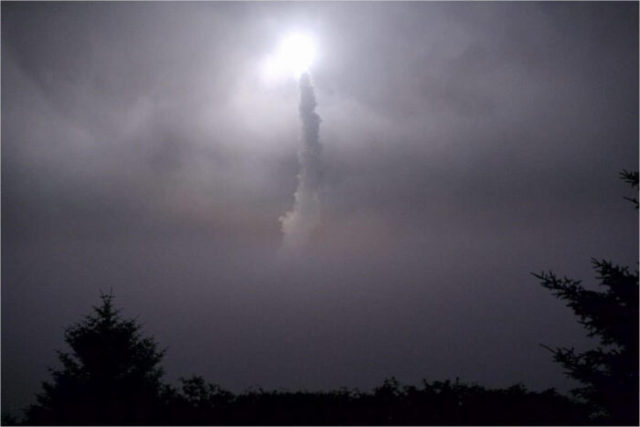
THAAD 01 test firing in 2017. An anti-missile struck an air-based missile defense system
Over the past two decades, ABM and Lockheed Martin have been working to further develop the system's capabilities, network options, and reliability. It is reported that two major breakthroughs have been achieved over the period 2019-2022.
So, in 2020, the US missile defense system demonstrated the direct integration of the Patriot system into the THAAD fire control system. During the first experiment in February 2020, THAAD successfully transmitted target designation data obtained using the AN/TPY-2 radar to the Patriot weapon system, which was able to develop a solution for interception.
Repeated tests took place on October 1, 2020. This time, the Patriot unit successfully intercepted the target missile. By 2022, integration has reached a higher level. On March 29, 2022, the THAAD complex successfully launched an advanced PAC-3 MSE missile to intercept a tactical BR without the support of a Patriot firing unit. This confirmed the concept of a possible connection of one or more Patriot PU to the THAAD battery.
The full integration of the Patriot PAC-3 MSE into the THAAD battery fire control system allows the latter to directly control the interception of missiles flying too low to be hit by the means of the main system, and increases the Patriot's chances of a successful interception. It is assumed that since the AN/TPY-2 radar has a much longer range than the conventional Patriot battery radar complex, this new capability will allow the effective use of Patriot missiles at their maximum firing range. This significantly increases the flexibility of a more powerful missile defense system, allowing for more rational deployment of anti-missile launchers, expanding the protected area, while simultaneously preserving more advanced THAAD interceptors for the most complex purposes.
The second major development is the remote fire control complex, introduced in 2019. The complex allows you to disperse individual THAAD battery PU hundreds of kilometers from each other, as well as from the battery radar and the fire control platoon. Interaction with the battery radar and the fire control platoon is carried out through a portable tactical communication system, which is deployed together with a separate PU.
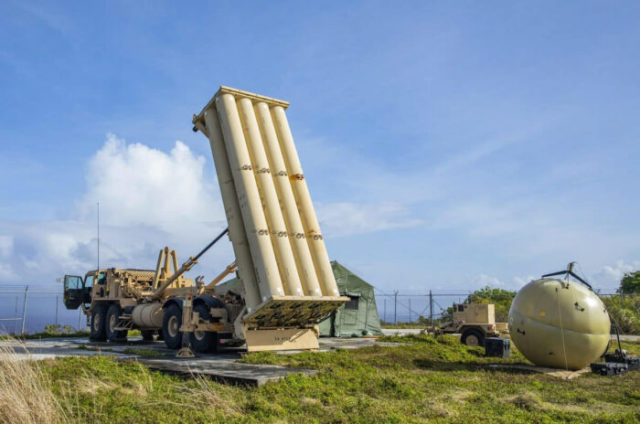
A THAAD PU and a portable tactical communications node in the shape of a ball (T2C2). Rota Island, Mariana Islands. The T2C2 node serves as a portable integrator between the centralized fire control unit and the dispersed THAAD PU.
The ability to disperse creates a more layered defensive architecture and increases the area that the system can protect. To date, this potential has been tested on the Mariana Islands and on the Korean Peninsula, where the tactical requirements for countering potential enemy missiles are considered the highest.
Accessibility and prospects
The first THAAD battery was put on combat duty in 2008. Currently, seven batteries are in operation, the last of which became part of the missile defense system in 2016. Two of these batteries are deployed abroad: one in South Korea, and one in Guam. Previously, periodic and sometimes long-term deployments were carried out on the territories of NATO, Japan and several countries of the Middle East.
The system is also available for export. The US government in 2017 agreed to sell THAAD to Saudi Arabia. An official contract for Lockheed Martin for the supply of 44 PU and 360 anti-missiles to Riyadh was signed in 2020 with a planned initial delivery date in 2023. According to the U.S. Army Corps of Engineers, the first four of several planned operational sites will be ready by 2026, and the rest will be completed by 2028. The total cost of the acquisition for Saudi Arabia is estimated at US$ 15 billion.
The United Arab Emirates became the first foreign operator of the missile defense system, signing a contract for two THAAD batteries in 2011 and sending its first calculations to the United States for training in 2015. The UAE also became the first country to carry out a combat interception, using THAAD to destroy a missile launched by the Houthis on January 17, 2022. In August 2022, the US State Department announced the approval of the sale of an additional 96 anti-missile and auxiliary equipment to the UAE.
The Missile Defense Agency (MDA) in April 2022 signed a contract with Lockheed Martin for the production of the eighth battery, which is expected to enter service in 2025. In addition to plans to create an eighth battery, Lockheed Martin announced that it continues to implement gradual improvements in the weapons system to increase its ability to withstand current and emerging threats. The Ministry of Defense continues to fund this initiative and has requested $220 million in fiscal year 2024 for further development of THAAD. The funds are planned to be spent on improving the reliability and availability of system updates, as well as improving the ability to withstand emerging threats across the entire current target spectrum.
An additional $47.6 million is being requested for THAAD testing as part of the MDA comprehensive master test plan. Planning includes flight and ground tests, as well as participation in war games and exercises. It is expected that in fiscal year 2024, the operation and maintenance of THAAD batteries will cost an additional $89.3 million.
In addition to these improvements to the basic system, Lockheed Martin has over the past few years proposed the development of a variant with an extended firing range (THAAD-ER) designed to counter hypersonic gliding units. To increase the range, a two-stage interceptor missile and an upgrade of the PU will be required. The manufacturing company assumed that the initial operability could be achieved within four years after the start of the project. To date, the MDA has not agreed to finance the development of the ER variant.
Based on the materials of the resource euro-sd.com
